Machine Gun
Battalions in WW1
When the US declared war in WW1 their arsenal included only 1,100 outmoded machine guns. John Moses Browning arranged a demonstration test of his improved design for a water-cooled machine gun at the Springfield Armory in May 1917.
Ordnance - Types - Artillery - Machine Guns - Chauchat [165-WW-384G-4] National Archives photo 45523853
"In the first test, the weapon fired 20,000 rounds with only a few malfunctions mostly related to poorly loaded cloth belts. The reliability was exceptional, so Browning fired another 20,000 rounds through the weapon with one broken part: a broken sear at about 39,500. The Ordnance Board was impressed but was unconvinced that the same level of performance could be achieved in a production model. Consequently, Browning used a second gun that not only duplicated the original trial, but it also fired continuously for 48 minutes and 12 seconds (over 21,000) rounds)." https://en.wikipedia.org/wiki/M1917_Browning_machine_gun
The Browning was considered a lightweight gun at 47 pounds as opposed to the German Maschinegewehr 08 that weighed in at 137 pounds. Production was slow so the Army relied on the Browning, the British Vickers that was built by Colt in the US or the Hotchkiss with the French Hotchkiss being the most common used by the US in the war.
"In the first test, the weapon fired 20,000 rounds with only a few malfunctions mostly related to poorly loaded cloth belts. The reliability was exceptional, so Browning fired another 20,000 rounds through the weapon with one broken part: a broken sear at about 39,500. The Ordnance Board was impressed but was unconvinced that the same level of performance could be achieved in a production model. Consequently, Browning used a second gun that not only duplicated the original trial, but it also fired continuously for 48 minutes and 12 seconds (over 21,000) rounds)." https://en.wikipedia.org/wiki/M1917_Browning_machine_gun
The Browning was considered a lightweight gun at 47 pounds as opposed to the German Maschinegewehr 08 that weighed in at 137 pounds. Production was slow so the Army relied on the Browning, the British Vickers that was built by Colt in the US or the Hotchkiss with the French Hotchkiss being the most common used by the US in the war.
Ordnance - Types - Artillery - Machine Guns - Chauchat [165-WW-384G-4] National Archives photo 45523853
"In the first test, the weapon fired 20,000 rounds with only a few malfunctions mostly related to poorly loaded cloth belts. The reliability was exceptional, so Browning fired another 20,000 rounds through the weapon with one broken part: a broken sear at about 39,500. The Ordnance Board was impressed but was unconvinced that the same level of performance could be achieved in a production model. Consequently, Browning used a second gun that not only duplicated the original trial, but it also fired continuously for 48 minutes and 12 seconds (over 21,000) rounds)." https://en.wikipedia.org/wiki/M1917_Browning_machine_gun
The Browning was considered a lightweight gun at 47 pounds as opposed to the German Maschinegewehr 08 that weighed in at 137 pounds. Production was slow so the Army relied on the Browning, the British Vickers that was built by Colt in the US or the Hotchkiss with the French Hotchkiss being the most common used by the US in the war.
"In the first test, the weapon fired 20,000 rounds with only a few malfunctions mostly related to poorly loaded cloth belts. The reliability was exceptional, so Browning fired another 20,000 rounds through the weapon with one broken part: a broken sear at about 39,500. The Ordnance Board was impressed but was unconvinced that the same level of performance could be achieved in a production model. Consequently, Browning used a second gun that not only duplicated the original trial, but it also fired continuously for 48 minutes and 12 seconds (over 21,000) rounds)." https://en.wikipedia.org/wiki/M1917_Browning_machine_gun
The Browning was considered a lightweight gun at 47 pounds as opposed to the German Maschinegewehr 08 that weighed in at 137 pounds. Production was slow so the Army relied on the Browning, the British Vickers that was built by Colt in the US or the Hotchkiss with the French Hotchkiss being the most common used by the US in the war.
Feeders of the Front lines:
Airplanes dropped ammunition for machine guns in forward positions
Freedom’s Triumph, Photo courtesy of Indiana War Memorial Archives
Soldiers Stories
Harry Williams Heacox, Pvt, Distinguished Service Cross, Marion County, Indiana
Co. I, 334th Reg., 33rd Div. “The distinguished service Cross cited by Major Bell and General Pershing. On the day before the armistice was signed on the Metz front, near Bois d’Arville, Private Heacox, put a German machine-gun nest of action taking command of this company, after all his officers and noncommissioned officers had been killed, leading them to their objective. He volunteered to go forward with Lt. Milton E. Wilson of Kirkland, Illinois, who was killed going forward, and put the machine-gun nest out with his rifle.
When he returned to his company with all the commission and noncommissioned officers being killed, there were only 30 men left of the original Co., who had been previously killed and wounded by this German gun nest, who he lead forward, gaining their objective. When orders came for the evacuation of the position only 18 men remained for Heacox to lead. Heacox began service in the front lines when picking Companies of his Regiment now being with the Australians in Amiens. In the early part of September 1918, the Australians were transferred to the American front on the edge of the Argonne Forest where they served until October 15 when they were transferred to Metz, where he was wounded and distinguished himself on November 10, 1918.”
Wounded by shrapnel in his left arm, hospitalized St. Mihiel, Toul, Savenay, Brest, France, and Greenhut Hospital, New York.
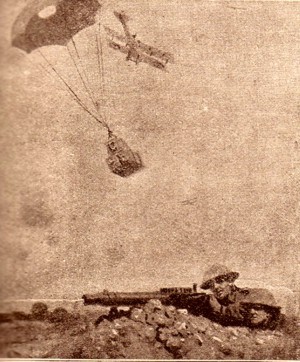
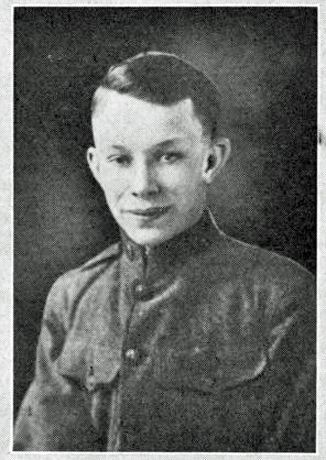
Pvt Henry William Heacox
Distinguished Service Cross
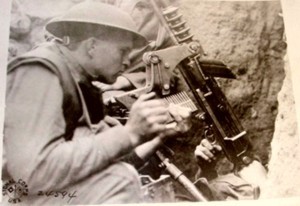
Hotchkiss Machine Gun
Anti-Aviation machine gun mounted in the trenches. The crew: Cpl. Clarence Hayes, gunner, Pvt. George B. Hugenson and Pvt. John G. Speede, Loaders.
This is a Hotchkiss Gun Co. C, M. G. Btn (in an unidentified Camp) near Germany.”
The gun, widely used by the French Army was manufactured in France. It fired up to 450 rounds per minute, weighed 88 lbs, {110 lbs. with tripod) and required a three-man team.
Photo courtesy of Indiana War Memorial Archives.
Machine-gun platoon of the 80th Div. advancing between La Chalade and Le Calon, Meuse.
National Archives photo 31991.
Forest L. Martz
Co C, 12th Machine Gun Bn 4th Div,
Tipton County, Indiana
Distinguished Service Cross:
"October 6, 1918, Private Martz learned that two wounded men were lying in a field some distance in advance of the front line. These men were in an exceptionally exposed position and had been without assistance for two days. After dark Private Martz, with another man, made two trips, 78 yards into the area between the lines bringing a man back each time. This was performed under enemy machine-gun fire and in the illumination of enemy flares."
Ben H. Menges
Elkhart County, Indiana
Distinguished Service Cross
"After having crawled out alone across a clearing swept by machine-gun fire, armed only with his rifle and bayonet, he succeeded in killing four of the enemy who resisted him, and after having cleaned out several dugouts in the woods, brought in eight prisoners and reported information which permitted breaking up an enemy counter-attack."
William Edgar Rice, Sergeant Bugler,
Co. K, 335th Infantry, 84th Div.,
Vanderburg County, Indiana
“Cited with Croix de Guerre, July 1, 1918, at Soissons by Marshall Petan, 5th French Army, for services rendered at Soissons with Signal Section of 1st Moroccan(?) Army
Wounded, Cantigny, April 28, 1918, in left leg by machine-gun. Wounded at La Petite Boise October 28 by machine-gun in Argonne Forest. Hospital treatment: Base #5, Paris, Field hospital #26, Noyer, France.
1st Wound, two machine-gun balls in left leg
2nd Wound, three machine-gun balls in right thigh
Battles: Cantigny, Chesprey, Chateau-Thierry, St. Mihiel, Meuse-Argonne, Sedan.
Andrew Nicholas Irrgang, AEF,
Ripley County, Indiana
Distinguished-Service Cross, Military Medal ( Great Britain), Croix de Guerre (France)
“Corporal Andrew Irrgang, Machine Gun Co., 120 th Infantry, distinguished himself by extraordinary heroism in connection with military operations against the enemy of the United States at Bellicourt, France on September 29, 1918.
“He had been separated from the rest of his platoon near Bellicourt, France, Sept. 1918. He kept his squad together and broke up an enemy machine gun nest, capturing the gunners and guns. As his own gun became disabled, Corporal Irrgang turned a captured machine gun around and fired one thousand rounds of ammunition, covering the advance of the infantry. He then continued to lead his squad forward under the artillery and machine-gun fire.”
Wounded by shrapnel, both legs, right arm & scalp
Edward William McAndrews,
Gold Star
Knox County, Indiana
Distinguished Service Cross:
Bois de Ogons, France: "Exposing himself fearlessly to enfilading machine-gun fire from the enemy, Sergeant McAndrews directed the placing of the guns in his section in such positions as to protect the advance of the Infantry and in so doing was fatally wounded. Despite the fact that one-half of his body was paralyzed as a result of his injury, he insisted upon remaining in command of his section until the action was over. He died in a field hospital shortly after being evacuated."
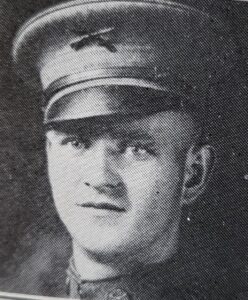
1st Sgt Leslie Albert McPike
Bedford, Lawrence County, Indiana
Co C, 8th Machine Gun Battalion, 3rd Division
Distinguished Service Cross
October 22, 1918 Sergeant McPike succeeded in breaking up a hostile counterattack, though his ammunition was exhausted in so doing. Shortly afterwards, when another counterattack was made against him, he and his men held off the enemy with their pistols, although at the time the Germans had closed in from three sides. Their courageous stand checked the enemy until fresh ammunition could be brought up, whereupon the hostile attack was completely repelled.
Silver Star and Division Citation
July 15, 1918
Seargent McPike maneuver his guns so successfully that he lost neither man nor guns though his original positions and the surrounding fortifications were completely destroyed.
Photograph of machine gunners of the
318th Machine Gun Battalion sitting on the ground, a
awaiting orders to go into action near
Haudiomont, France, on November 10. 1918
US Signal Corps photo
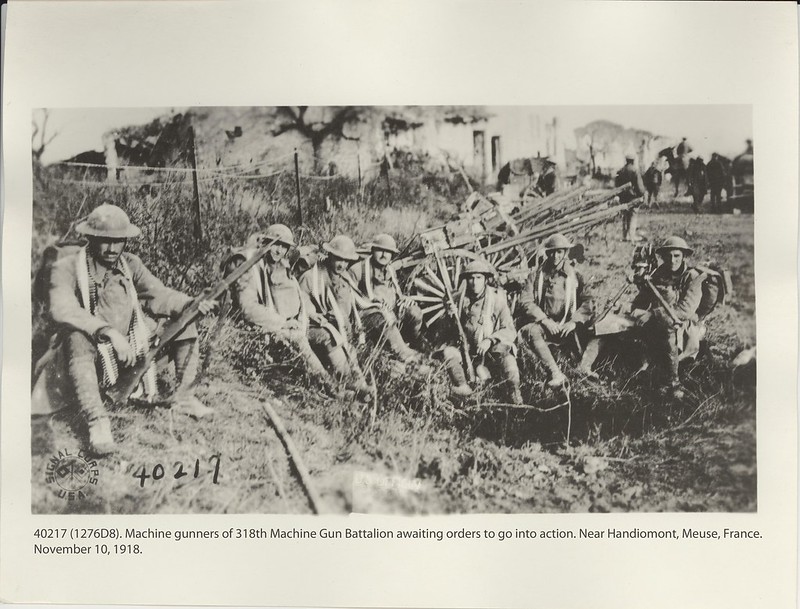

View of the 24th Machine Gun Battalion at Camp Fremont near Palo Alto, California, on September 28, 1918
Herbert Wes McBride, 139th Machine Gun Battalion,
Canadian Infantry,
Marion County, Indiana
Commissioned Captain, Musketry Instructor, 38th Canadian Infantry Battalion, January 14, 1915, at Ottawa, Ontario. Resigned commissioned and entered as Private, 21st Canadian Infantry Battalion (Machine-gun Section) at Kingston, Ontario.
Trained Kingston, and Barriefield until May 5, 1915., Sailed for England (for Montréal on SS Metagama) May 6, 1915. Landed at Plymouth, Devonshire, England, May 14, 1915. Trained at West Sandling Camp, Kent, England until September 13th.
Sailed from Southampton, September 13, and landed at LeHavre, France, September 14, 1915, proceed immediately to the front, arriving front-line trenches near Messines, West Flanders, Belgium, September 19, 1915. Moved to Wyschaete-St. Eloi sector, (Ypres salient), October 8, 1915. Remained in Ypres salient until June 20, 1916. Promoted: Lance Corporal September 19, 1915, Corporal October 15, 1915, Sergeant December 26, 1915, 1st Lieutenant May 31, 1916. Return to England June 20, 1916, and acted as instructor, 39th Canadian Infantry Battalion at West Sandling Camp. Made several trips as conducting officer, taking replacement troops to France during July and August, and as a messenger (King's Messenger) between London War Office and Hdqtrs. 3rd Echelon, Rouen, France.
Assigned to 18 Canadian Infantry Battalion, September 15, 1916, and reported for duty near Courcelette, Picardy, September 28, having previously participated in an engagement which resulted in the capture of Combles, as a volunteer machine-gun officer with the 1st Gloucestershire Regiment.
Wounded and sent to hospital, October 10th – 12th, to England October 27th in back to France, December 5, 1916, reporting for duty with 18th Battalion in trenches in front of Bully-Grenay, opposite Lens, remaining there until January 28, 1917, when we shifted to Neuville-St. Vaest, opposite Vimy Ridge.
Invalided out to England, February 22, and discharged for physical disability with the rank of Captain to date from November 9, 1916.
Return to the United States on SS St. Paul, leading Liverpool, April 7, landed in New York, April ?, 1917.
Hospitals: British Red Cross General Hospital #12; St. Pol; Lady Murry’s, LeTreport; Miss. Pollocks, 50 Weymouth St., London; Queen Alexandria's Military Hospital, London; Canadian Eye and Ear Hospital, Folkstone; several field hospitals at Warloy, Doullens and Frevent, numbers unknown.
Decorations:
British Military Medal, June 2, 1916, presented by King George V, Buckingham Palace London.
French Medaille Militaire, November 9, 1915, presented by General d’Oissell at Bailleul, March 17, 1916.
French Croix de Guerre with palm, award of September 25, 1916; presented October 16, 1916, at St. Pol by General (now Marshall) Foch.
Battles and engagements: Loos, September 25, 1915, Ypres salient: The Bluff, St. Eloi, Hooge, Hill #60 & Sanctuary Wood, the Somme: Combles, Courcellette and Regina Trench, Arras Sector: Cologne and preparations for Vimy Ridge attack. Took part in numerous trench raids and all above sectors.
Wounded: November 9, 1915; February 27, 1916, and October 10, 1916 “officially” and slightly and several other occasions, gassed, more or less severely, numerous times, burned and bruised by shell fire many times.
Clarence Shert, Private, Machine Gun Btn.,
Jefferson County, Indiana
“I have heard and read a great deal about open warfare and know I'm going through it, you can imagine how awful it is.
“We were in a large woods a short time ago, and our artillery was all around us. The Boches shelled the woods night and day. We get it again, every man had his own dugout, protection against shrapnel. You could scarcely take two steps for fear of falling headfirst into a dugout.
“I am sitting out in front of my dugout writing this letter and old Fritz is sending 5” shells over in front of us about 50 yds. from here. If he lowers his elevation, I will do the groundhog stunt.
“You read in the newspapers how the French people are driven from their homes on short notice. Well, as we were moving up to this front, we passed family after family running from the dangers zone, and believe me it was simply awful to see them go by, not only forty or fifty, but hundreds of them. Some in motor trucks, some in wagons with their children, with probably only enough clothing and food to last them a few days.
“The less fortunate ones were pulling their wagons, caring stuff on their backs, and on wheelbarrows. I saw one old woman have a wheelbarrow loaded with some provisions lying by the roadside. The poor soul had given out. It made my heartache. Another case and old man and dog were pulling a spring wagon and old woman pushing it. I don't know how they made it upgrades. They left their homes and all they had. They will probably come back someday, but only see their homes all destroyed.”
Corporal Robert L. King,
Jefferson County, Indiana
Camp Cody, New Mexico :
“Since coming here have been assigned to a machine gun company. We drill here as squads. There are eight men in the squads, including the Corporal. I have been acting as Corporal, ever since I landed here. Every Corporal has to give commands for his squad, which is not a very easy thing for me too. But even at that, I like it.
We've been taught how to kill the Germans and we sure ought to get some of them with these machine guns for they shoot 600 times a minute. It takes two-men to feed in the bullets, we are not supposed to get in the trenches with the infantry but slightly to the rear, for we shoot over the infantry's heads. We are stationed at both ends of the trenches.
I don't think I could have gotten into any part of the army that I would have liked better than this. We do not have rifles but will have a pistol and a large knife to defend ourselves in hand-to-hand fighting.
There are 30,000 soldiers here are in only a few of them have guns, the rest have clubs, which they used to kill jackrabbits. When the boys are off duty they form a large circle make a drive for jackrabbits. They get as many as 40 or 50 at a time, and it sure is lots of fun.
We are well taken care of in this camp, there is no need to worry about me for I never had such an appetite as I have now, and they sure do feed us well and it all tastes good and plenty of it.
For supper, we had roast beef, sweet potatoes, gravy, rice pudding, prunes, blackberry jam, bread, and cocoa. Sometimes we have oyster soup and cranberry sauce, and sometimes more than this to eat. No one needs to go hungry. I never expected to give such meals to the army.
As I know of nothing more to write to you at this time, I will close and hope to receive the mail from you soon.
As ever, your son, Robert"
The Lewis Gun
A gas-operated .306 gun manufactured by Savage Arms Co. The lewis gun proved to be reliable and was copied by the Japanese in WW2. It was designed by US Col Isaac Newton Lewis but the US Army initially turned down the gun. Lewis took his design to Europe and it was adopted by Belgium and produced by the Birmingham Small Arms Co. and approximately 100,000 were used by the Allies in World War 1. It could fire 500-600 rounds per minute and was especially valuable to the air corps because of its minimal recoil.
Public Domain, https://commons.wikimedia.org/w/index.php?curid=186665
Machine Gun Team
"Machine gun team of an American balloon company at work on the French Front, trying to get an enemy airplane. These anti-aircraft guns are known as 'Archies'".
America's War for Humanity
Browning Machine Gun
M10-17 Browning.30" machine gun was adopted at the start of WW1. It weighed less than 25 lbs. and was adapted for use on airplanes. It was gas-operated, water-cooled, belt fired, and could fire 500 rounds per minute.
Indiana War Memorial Exhibit
Roasted Bakra
More testimonials
Sergeant Wilbert Kendall, Co. A, Machine Gun Bn., 2nd Div.,
Decatur County,
"First local boy to return from France, having started the big drive over there year.
Sergeant Wilbur Kendall landed in Greensburg at 10:35 this morning fresh from the battlefield of France and enjoys the distinction of being the first Decatur County soldier who has return from service overseas since the war began.
Sergeant Kendall told of the dead German near the front line American trenches and how an American covered the body with dirt. When the job was completed, the Huns feet were still visible and a card bearing the words, “rise your country needs you” was pinned thereon. He said the same to be applied here and that everyone should rise to do their part in the great struggle for freedom.
He paid special tribute to General Pershing and said that he was idolized by the men of the Army. He also took occasion to praise of foreigners in the United States Army and declared that “Wops” as they were familiarly known, constituted the division that saved Paris. Speaking of the French people, Sergeant Kendall said that despite their great sacrifices they were not broken by the war, and he would fight to the end for a victorious peace. He praised them for their hospitality and said that they're willing to share with the allies. He said he was glad to be back in the states where he could get three square meals a day and then he said the Americans on the fighting line were not always favored that way.
In speaking of the Red Cross, he said the people could not give too much to the organization for noble work that is being carried 'over there'. If you heard that wounded man lying all night in a wheat field and crying for aid as I did. you would understand” he said in closing."
Walter Grant Grubb, Corporal, Co. D, 115th Inf., 29th Div.,
Daviess County, Indiana
He volunteered to locate a machine gun that was holding up the advance of his company & was one of the parties that successfully attacked the machine-gun nest, thereby allowing the company to continue its advance. Bois de Consenvoy, Oct. 10, 1918., Oct. 10, 1918.
Benjamin Harrison Harre, Sergeant, Co. K, 131st, Sergeant, Co. K, 131st In, 33rd Div.,
Marion County, Indiana.
Upon discovering an enemy machine gun nest, under heavy fire, he flanked the position, captured the machine gun & thirty-one prisoners, one of them an officer, killing two of the enemy who tried to escape.
Ernest Franklin Hess, USMC, Gunner,
Ripley County
“Wounded at Belleau Wood. Struck in left thigh, both arms and left eye. Hospitalized for five weeks to recover and fitted with a glass eye.
“Came over in a Hospital ship in a Casual Co. We sent on arrival to the Naval Hospital at Portsmouth, Va. For two months. Was sent to the Marine Barracks at Norfolk Va. for one month.
“Served as a gunner on an outpost when wounded at Belleau Wood, June 23, 1918.
“Service in the trenches at Verdun consisted of raiding, extending excavations of trenches and building roads. Was under constant shellfire and subject to gas attacks almost every night.
“Had only a week’s rest after the Verdun trenches until sent to Chateau-Thierry. Advanced eight days in this attack, doing hand to hand fighting with nets, rifles and machine-guns. (French ‘sho-sh’ guns). Marched back for rest when relieved by 7th Infantry. A barrage was put over the first night after this relief. The 7th Infantry fell back for this, the Germans rushed in and retook all the Marines had gained in the eight days. “The 6th Marines were sent immediately to relieve the 7th and went again into battle about 8 or 9 AM, June 2, 1918. They succeeded in retaking Belleau Wood, advancing four kilometers. They continued the advance for twenty-odd days until the entire wood was taken and held.
“Private Hess carried a wounded Lieutenant from a hill in Belleau Wood to a First Aid station in a ravine. The Lieutenant was then carried by the First Aid men to a Field Hospital. Both of these men received medals for this action. Orders to all Marines were to drag wounded out of further danger, so this action was in the line of duty. Nearly all soldiers served their comrades in this way.”
Daniel Leroy Jack, Private, Co. F, 362nd In,., 91st Div.,
Adams County, Indiana
He rushed with two other soldiers over open ground, exposed to the fire of the enemy artillery & displayed the finest courage in charging a machine-gun nest, killing two gunners, wounded two others, & captured five prisoners as well as the piece.
Gailard. Nail, Sergeant, Co. A, 7th Engineers, 5th Div.,
Wabash County, Indiana
Under heavy & continuous machine-gun fire, he held stubbornly to their position, securing an enemy machine gun & ammunition and courageously advanced against enemy Infantry. Wounded Oct. 15, 1918.
Thomas D. Smith, Sergeant, Infantry,
Tippecanoe County, Indiana
Entered service May 3, 1918. Stationed at Camp Ferre, Ga. and Camp Upton, N.Y. Sailed for overseas duty, a member of 52nd Infantry, Headquarters 6th Bn, Signal Corps. Saw active service on the front lines. Was awarded the Croix de Guerre with three other comrades for bravery, having gone under shell and machine-gun fire at the risk of life to remove a German electric wire, in order that the remains of a Lt., killed by contact with it could be removed, and the way cleared for the patrols. Was wounded in the right hip. Born in Lafayette, Ind., May 6, 1896; son of Thomas D. and Fannie B. Smith. Wife is Mabel Smith. Home is Lafayette. Ind.
Hiram Quincy Cox, K. I. A.,
Grant County, Indiana
“Hiram Quincy Cox., 1st Class Private, 5th Machine Gun Battalion, 23rd Infantry.
He died bravely fighting for his God and HIS COUNTRY. He was a Christian.
Headquarters, 23rd Infantry, 2nd Div., Camp Travis, Texas, Headquarters, 5th Machine Gun Battalion, Camp Travis, Texas
Private Cox was a member of Co. C, 5th Machine Gun Battalion, and was attached to the Marine Brigade during the capture of Boureschesquad of which he was a member, did some valuable work in this attack, and the survivors were personally thanked by the Commanding General.
Private Cox was killed by an enemy machine-gun bullet after Boureschesas taken and while lines were being consolidated. He was a brave and capable soldier and a credit to the 2nd Division. Eustace P. Stuart, 1st Lt., 5th Machine Gun Battalion
Edgar William Tatman, 1st Lt., Shelbyville,
Shelby County, Indiana
“Enlisted May 11, 1917. Entered Officers Training Camp at Fort Benjamin Harrison, May 15, 1917. Commissioned 1st Lt. of Ordnance, United States National Army - August 22, 1917. Study the manufacturing and operations of machine guns at the government arsenal school in Washington DC and Utica, New York. Studied and tailored this work in Springfield, Massachusetts. The charge of troops at Camps Cox and Jackson.
In France: Studied and taught the synchronization of machine guns and bombing and methods of dropping bombs from airplanes at Ordnance Armament School near Juan de Mont., about 50 miles from Nantes. Had charge of the salvage of small arms at Mehun e Yeine.
Is the author of a book on aerial bombing. Was to leave November 11, 1917, for the front to engage in the work of dropping bombs from airplanes. Discharged August 22, 1919."
Charles William Whitehead, Sergeant, Infantry,
Tippecanoe County, Indiana
Entered service June 26, 1916, stationed at Indianapolis, Ind., in Co. C, 2nd Indiana Inf. Sent to Rio Grande, Tex., and transferred to the 2nd Indiana Machine Gun Corps. Sent to Ft. Harrison, Ind., where he was mustered out of service Feb. 28, 1917. Re-entered the service again in the late war in March 1917. Stationed at Jefferson Barracks, Mo., for Government Depot Work. Was transferred to Indianapolis, Ind., to instruct training corpsmen in the use of Louis Machine Gun. Received his promotion of sergeant and sent to Camp Shelby, Miss., where he acted as a supply sergeant,152nd Inf., until October 1918. Saw service overseas and was at the front when the armistice was signed. Born at Wea Plains, Ind., Sept. 30, 1898, son of Charles F. Whitehead. Home is West Point, Ind.
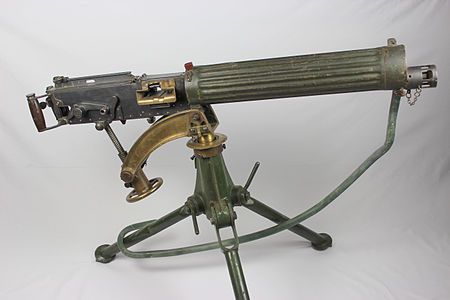
Standard Vickers machine gun with tripod mount and associated ammunition belt, ammunition box plus petrol can (as a condenser can) with hose. The Vickers Gun was the standard British machine gun from 1912. It was heavy and mounted on a tripod, requiring a team of six men to transport it to and operate it on the battlefield. Although difficult to use on advancing troops, machine guns were used to deadly effect from defensive positions.
Photo credit: York Museum Trust as part of a GLAMwiki partnership.
https://commons.wikimedia.org/wiki/File:Vickers_Machine_Gun_YORCM_CA78ac.JPG
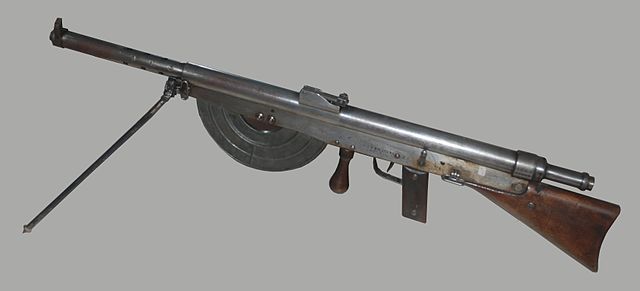
Chauchat Machine Gun was the standard light machine gun of the French Army and AEF. Could be carried and operated by one man. The American version was noted for being unreliable.
By Janmad - Own work, CC BY 3.0, https://commons.wikimedia.org/w/index.php?curid=7723650
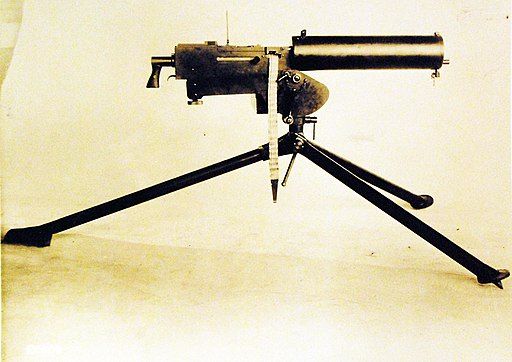
WWI: American Expeditionary Forces: Weapons. Browning Machine Gun, 1918 model, water-cooled, and called “Browning Heavy Machine Gun.” This gun is fed from a belt of 250 rounds of cartridges. The most important features are endurance and simplicity of mechanism, rendering manufacturing easy. In a government test, 39,500 shots were fired without a break. At another test, 20,000 shots were fired in 48 minutes, 16 seconds, without malfunction and only three stoppages, each due to a defective cartridge. The gun weighs 34 pounds, with the water jacket filled.
U.S. Army Signal Corps Photograph. Courtesy of the Library of Congress.